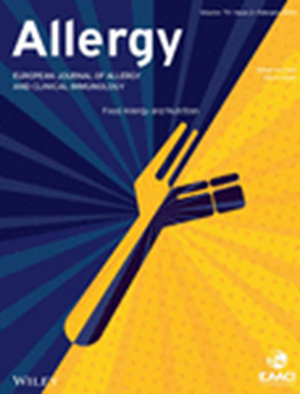Mepolizumab Effectiveness in Severe Asthma With/Without Chronic Rhinosinusitis With Nasal Polyps: Real‐World Pooled Analysis
IF 12.6
1区 医学
Q1 ALLERGY
引用次数: 0
Abstract
BackgroundSevere asthma with an eosinophilic phenotype (SAEP) and chronic rhinosinusitis with nasal polyps (CRSwNP) are predominantly type 2‐driven diseases, characterised by eosinophilic inflammation and substantial disease burden. Mepolizumab, a humanised monoclonal antibody that targets interleukin‐5, a key cytokine in type 2 inflammation, is an effective, approved treatment both in SAEP and CRSwNP. We aimed to analyse real‐world evidence of mepolizumab effectiveness in patients with comorbid SAEP and CRSwNP.MethodsThis study pooled five existing, predominantly European cohorts to describe the impact of mepolizumab on the rate of clinically significant exacerbations (CSEs) and other outcomes in adults with SAEP without and with comorbid CRSwNP (SAEP[−]CRSwNP and SAEP[+]CRSwNP, respectively).ResultsOverall, 1037 patients were included. Baseline characteristics were similar in both cohorts. Mepolizumab was associated with a reduction from baseline in the annual rate of CSEs at 12‐months post‐initiation (SAEP[−]CRSwNP: 72.7%; SAEP[+]CRSwNP: 79.7%), irrespective of baseline blood eosinophil count (BEC). When patients with SAEP[+]CRSwNP were compared with patients with SAEP[−]CRSwNP, a 30.0% incremental benefit in the reduction of CSEs was observed. At 12‐months post‐initiation, mepolizumab was also associated with a reduction in oral corticosteroid use and BEC, and an improvement in lung function and Asthma Control Test (ACT) scores in both cohorts. Post‐mepolizumab initiation, ≥ 3 clinical remission criteria were fulfilled by 47.2% and 52.3% of patients with SAEP[−]CRSwNP and SAEP[+]CRSwNP, respectively.ConclusionsThe results provide a greater understanding of mepolizumab's effectiveness, demonstrating a substantial improvement in asthma outcomes, irrespective of baseline BEC and the presence of comorbid CRSwNP.Mepolizumab治疗伴/不伴慢性鼻窦炎鼻息肉的严重哮喘的有效性:真实世界汇总分析
重度哮喘伴嗜酸性粒细胞表型(SAEP)和慢性鼻窦炎伴鼻息肉(CRSwNP)主要是2型驱动型疾病,其特征是嗜酸性粒细胞炎症和大量疾病负担。Mepolizumab是一种针对白细胞介素- 5(2型炎症的关键细胞因子)的人源化单克隆抗体,是一种有效的治疗SAEP和CRSwNP的药物。我们的目的是分析mepolizumab对合并SAEP和CRSwNP患者有效性的现实证据。方法:本研究汇集了5个现有的欧洲队列,以描述mepolizumab对无CRSwNP和合并CRSwNP(分别为SAEP[−]CRSwNP和SAEP[+]CRSwNP)的成人SAEP的临床显著加重率(cse)和其他结局的影响。结果共纳入1037例患者。两个队列的基线特征相似。Mepolizumab与起始后12个月CSEs年发生率较基线降低相关(SAEP[−]CRSwNP: 72.7%;SAEP[+]CRSwNP: 79.7%),与基线血嗜酸性粒细胞计数(BEC)无关。当SAEP[+]CRSwNP患者与SAEP[−]CRSwNP患者进行比较时,观察到CSEs减少的30.0%增量获益。在开始治疗12个月后,mepolizumab还与两个队列中口服皮质类固醇使用和BEC的减少以及肺功能和哮喘控制测试(ACT)评分的改善相关。mepolizumab启动后,SAEP[−]CRSwNP和SAEP[+]CRSwNP患者分别有47.2%和52.3%达到≥3个临床缓解标准。结论:该结果为mepolizumab的有效性提供了更好的理解,证明了哮喘结局的实质性改善,无论基线BEC和是否存在合并症CRSwNP。
本文章由计算机程序翻译,如有差异,请以英文原文为准。
求助全文
约1分钟内获得全文
求助全文
来源期刊

Allergy
医学-过敏
CiteScore
26.10
自引率
9.70%
发文量
393
审稿时长
2 months
期刊介绍:
Allergy is an international and multidisciplinary journal that aims to advance, impact, and communicate all aspects of the discipline of Allergy/Immunology. It publishes original articles, reviews, position papers, guidelines, editorials, news and commentaries, letters to the editors, and correspondences. The journal accepts articles based on their scientific merit and quality.
Allergy seeks to maintain contact between basic and clinical Allergy/Immunology and encourages contributions from contributors and readers from all countries. In addition to its publication, Allergy also provides abstracting and indexing information. Some of the databases that include Allergy abstracts are Abstracts on Hygiene & Communicable Disease, Academic Search Alumni Edition, AgBiotech News & Information, AGRICOLA Database, Biological Abstracts, PubMed Dietary Supplement Subset, and Global Health, among others.
 求助内容:
求助内容: 应助结果提醒方式:
应助结果提醒方式:


